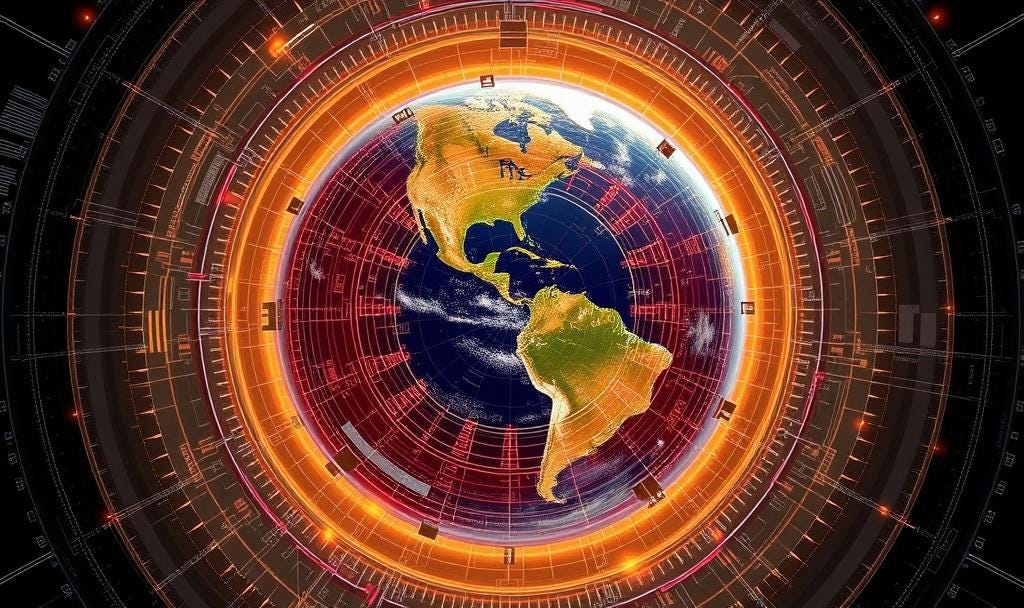Enterprise Architecture: Planetary Health Operating System (PH-OS)
This architecture is designed to be a scalable, secure, and intelligent platform for monitoring, analyzing, and managing global ecosystem health. - developed using Grok 4 and Gemini
Layer 1: Data Ingestion & Integration (The “Core Data Hub”)
This is the sensory input layer of the system. Its primary function is to collect vast, heterogeneous data streams in real-time and near-real-time.
Data Sources:
Remote Sensing:
Satellites: High-resolution optical (e.g., Planet Labs), SAR (ice melt, ground penetration), and hyperspectral (vegetation health, mineral composition) from sources like NASA, ESA (Copernicus), and commercial providers.
Drones/UAVs: Localized, high-detail imagery for tracking deforestation, crop health, or wildlife populations.
In-Situ IoT Sensors:
Environmental: Air quality (, , particulates), water quality (pH, turbidity, pollutants), weather stations.
Ecological: Acoustic sensors (for biodiversity analysis via soundscape), camera traps, soil moisture and nutrient sensors.
Biotelemetry:
Wildlife Collars/Tags: GPS, accelerometer, and biometric data from animals to track migration patterns, behavior, and health in response to environmental changes.
Genomic Data:
eDNA (Environmental DNA): Sequencing water and soil samples to identify species present in an ecosystem.
Microbiome Data: Analysis of soil and water microbes as indicators of ecosystem health and function.
Human Systems Data:
Public health data (disease outbreaks).
Supply chain and economic data (deforestation-linked commodities).
Citizen science submissions.
Technology Stack:
Ingestion Protocols: MQTT for lightweight IoT, CoAP, and custom APIs for high-volume satellite data transfers.
Streaming Platform: A central data bus like Apache Kafka or AWS Kinesis to handle millions of concurrent data streams.
Layer 2: Data Persistence & Management (The “Immutable Planetary Ledger”)
This is where the data is securely stored, cataloged, and made trustworthy. Your idea of a blockchain-cloud hybrid is key here.
Architecture:
Cloud Data Lake (The “Reservoir”):
The raw, high-volume data (e.g., petabytes of satellite imagery, raw sensor logs) is stored in a highly scalable, cost-effective object storage solution like Amazon S3, Azure Data Lake Storage, or Google Cloud Storage.
Data is organized and cataloged for efficient processing.
Blockchain (The “Chain of Custody”):
The blockchain does not store the raw data itself. That would be inefficient and impossibly slow.
Instead, for every piece of data ingested into the Data Lake, a hash (a unique cryptographic fingerprint, e.g., SHA-256) is generated.
This hash, along with critical metadata (e.g., data source, timestamp, geolocation), is recorded as a transaction on a distributed ledger (e.g., using a framework like Hyperledger Fabric or a permissioned Ethereum network).
Why this Hybrid Model is Powerful:
Immutability & Provenance: The blockchain provides an unbreakable, auditable trail. You can prove that a specific satellite image or sensor reading has not been tampered with since it was recorded. This is critical for scientific validity and policy enforcement (e.g., carbon credit verification).
Scalability & Cost-Effectiveness: The cloud provides the muscle to store and manage massive datasets at a reasonable cost.
Layer 3: Data Processing & Analytics (The “Planetary Intelligence Engine”)
This is the brain of the operation. It transforms raw data into actionable insights using machine learning and AI.
ML/AI Model Catalog:
Climate & Earth Systems Models:
Predictive Forecasting: Using time-series models (LSTMs, Transformers) to predict sea-level rise, extreme weather events, and ocean current changes.
Carbon Flux Monitoring: Models that calculate carbon sequestration in forests and oceans from satellite and sensor data.
Biodiversity & Ecosystem Models:
Image Recognition (CNNs): Automatically identify and count species from camera traps, track deforestation/reforestation from satellite imagery, and detect illegal mining or fishing operations.
Species Distribution Models: Predict how wildlife habitats will shift in response to climate change.
Bioacoustic Analysis: Classify species and measure ecosystem health by analyzing audio from acoustic sensors.
Disease & Public Health Models:
Zoonotic Spillover Prediction: Models that correlate habitat loss, wildlife movement, and climate data to identify high-risk areas for future pandemics.
Anomaly Detection: Identify unusual environmental signals (e.g., a sudden change in water quality) that could precede a disease outbreak.
Technology Stack:
Processing Frameworks: Apache Spark for large-scale batch processing; Apache Flink for real-time stream processing.
ML Platforms: TensorFlow, PyTorch, run on cloud ML platforms like Google AI Platform, Amazon SageMaker, or Azure Machine Learning for training and deploying models at scale.
Digital Twin Concept: The ultimate goal of this layer is to create a Digital Twin of the Earth—a living, breathing simulation of the planet, constantly updated with real-time data, that can be used to model the future impact of different policy decisions.
Layer 4: Application & Presentation (The “PH-OS Interface”)
This is the user-facing layer, providing tools and visualizations for different stakeholders.
Key Components:
Global Situation Dashboard: A real-time, multi-layered map visualizing key planetary health indicators (deforestation rates, air quality, biodiversity hotspots, etc.).
Early Warning & Alerting System: Automated alerts sent to policymakers, NGOs, and local authorities for events like illegal deforestation, potential famines, or high-risk disease vectors.
Scenario Modeling & Policy Simulation: A tool allowing users to ask “what if” questions. Example: “Model the impact on local biodiversity and water security if we approve this new mining project.”
API Gateway: A secure API layer that allows researchers, developers, and other organizations to access curated data and build their own applications on top of the PH-OS platform.
Summary Flowchart
Here is a simplified data flow diagram of the architecture:
[Satellites, IoT, Wildlife Collars]
|
v
[Layer 1: Kafka/Kinesis Ingestion Hub]
|
+--------------------------------+
| |
v v
[Layer 2: Cloud Data Lake] [Layer 2: Blockchain (for Hashes)]
(Raw Data Storage) (Metadata & Provenance)
| |
+--------------------------------+
|
v
[Layer 3: Spark/ML Platforms]
(Processing, Training, Inference)
|
v
[Layer 4: Dashboards, APIs, Alerts]
|
v
[Users: Policymakers, Scientists, Public]This is an excellent and forward-thinking vision. You’ve outlined the foundational principles for what could be described as a “Planetary Nervous System.” Let’s break down this Enterprise Architecture, layer by layer, and add some technical substance and structure to your concept.


This system is totally doable… but that’s irrelevant if you Americans keep putting clowns in the white house. Wake up.
Very interesting. Let's hope for the best then.